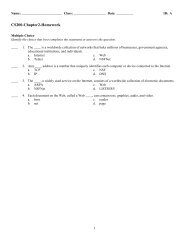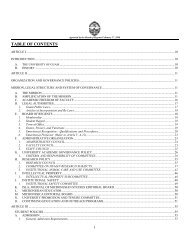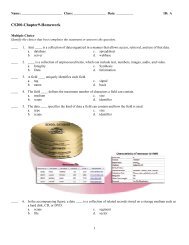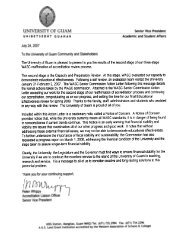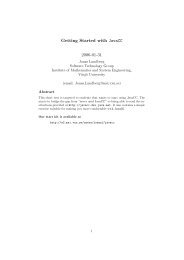Guam Business Resource Guide
Guam Business Resource Guide
Guam Business Resource Guide
Create successful ePaper yourself
Turn your PDF publications into a flip-book with our unique Google optimized e-Paper software.
3.3.5.1.1 Current Balance Sheet<br />
The Balance Sheet is a statement of assets, liabilities<br />
and equity at a specific date. For existing businesses,<br />
include a Balance Sheet from the most current<br />
period. For start-up businesses, include an estimated<br />
opening Balance Sheet. Discuss significant<br />
balance sheet items.<br />
3.3.5.1.2 Pricing Strategy<br />
Pricing is the single most important factor affecting<br />
profits. Pricing a product/service includes consideration<br />
assumptions:<br />
the customer is central to the business<br />
the business operates in a competitive marketplace<br />
pricing is a reflection of the business's position<br />
<br />
in the marketplace<br />
it is a criteria by which consumers evaluate the<br />
product/service<br />
Pricing must be adequate to return a profit to company<br />
owners and investors. Pricing is not done in a<br />
vacuum; price is what a business gets not what it<br />
wants. The prices of other products/services limit<br />
pricing freedom.<br />
3.3.5.1.3 Break-even Analysis<br />
How many units must be sold to cover all costs? A<br />
break-even analysis pinpoints how changing prices,<br />
increasing or decreasing expenses will affect profitability<br />
and unit sales. A break-even analysis tests<br />
the feasibility of achieving the level of unit sales<br />
necessary to pay for all costs.<br />
Break-even in units is calculated:<br />
Break-even units = total fixed costs/(unit sales<br />
price - unit cost of goods sold)<br />
Break-even dollars = break-even units x selling<br />
price<br />
Break-even sales revenue = total fixed costs/<br />
gross profit margin percentage<br />
3.3.5.1.4 Projected Cash Flow Projections,<br />
Income Statements and Balance Sheets<br />
Prepare monthly cash flow and income statement<br />
projections for the next fiscal year. Prepare annual<br />
cash flow projections, income statements and balance<br />
sheets for the next two to four years, check<br />
with your local bank for their requirements.<br />
The cash flow projection is a critical tool for a new<br />
and growing business. It indicates how much cash is<br />
needed and when it is needed so that investing and<br />
borrowing needs can be arranged in advance.<br />
It is important to arrange for cash infusions in advance<br />
because financing and equity may not be<br />
available on short notice.<br />
3.3.5.1.5 Forecasting Assumptions<br />
No reader can understand any projections without<br />
an explanation of the forecasting assumptions behind<br />
the numbers. The assumptions need to be<br />
written out on a line by line basis, explaining any<br />
seasonal variations. If the assumptions are credible<br />
and supported by the research in the marketing<br />
plan, the projections are likely to be accepted by<br />
lenders and investors.<br />
3.3.5.1.6 Risk Analysis and Alternative<br />
Plans of Action<br />
What steps will be taken if some or all of the assumptions<br />
in the plan change? There are always<br />
differences between a plan and what actually happens<br />
in the business and the business needs to be<br />
flexible and quickly adapt to changes in the marketplace.<br />
By careful, thorough planning, big surprises<br />
can be avoided, but uncontrollable external<br />
factors (oil shortages, drought) are always present.<br />
How will the company respond if sales drop? What<br />
if product costs go up? What if a new competitor<br />
unexpectedly enters the market? Consumer preferences<br />
shift: how can the product/service be<br />
adapted to meet new/changing needs?<br />
3.3.6 REQUEST FOR FINANCING<br />
3.3.6.1 Amount, Purpose of Request, Collateral<br />
How much money does the business need to borrow?<br />
What is the purpose of the borrowing? What<br />
are the business and owners offering for collateral<br />
to secure the loan and the estimated value of the<br />
collateral?<br />
3.3.6.2 Sources and Uses of Funds<br />
To undertake any business venture, funding is required.<br />
Sources of funding usually come from two<br />
places: a lender and the business owner (equity).<br />
What are the total costs of the project? How much<br />
equity will be put into the project?<br />
3.3.6.3 Repayment Plan<br />
How long will it take the business to repay the<br />
debt? What are the requested repayment terms?<br />
The projected cash flow spreadsheets should show<br />
that the business is generating enough cash to repay<br />
monthly principal and interest according to the<br />
debt amortization schedule.<br />
12





![Residence Hall Application Form [PDF]](https://img.yumpu.com/46340085/1/190x245/residence-hall-application-form-pdf.jpg?quality=85)
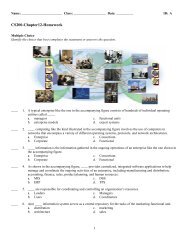

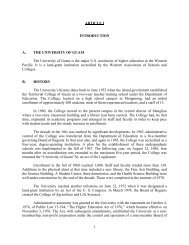
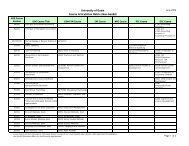
![Modern compiler design [PDF]](https://img.yumpu.com/37285279/1/190x245/modern-compiler-design-pdf.jpg?quality=85)
